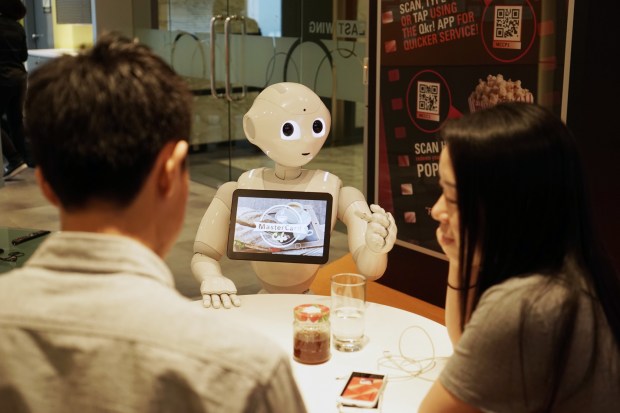MasterCard Makes Robots Pay

Meet Pepper, the 4 foot (sorta) humanoid figure that will take orders at Pizza Hut and even let the consumer pay for it. Science fiction? How about QSR reality. John Sheldon, SVP of Innovation at MasterCard Labs, tells Karen Webster how human-like robots could change how consumers both order and pay for their food.
MasterCardWe don’t have to look far to see the ways in which cartoons and comics of the past – with their futuristic tools and services – are influencing the advancing technologies we see hitting the market today.
Though we may not have reached the threshold of flying cars and warp drives just yet, robotics are quickly starting to change the ways in which humans approach many different aspects of our everyday lives.
One robot in particular named Pepper, created by SoftBank Robotics Holdings Corp. and known for its ability to read and express human emotions, is looking to innovate order taking and payment acceptance in Pizza Hut restaurants across the Asia-Pacific region.
John Sheldon, SVP of Innovation at MasterCard Labs, recently sat down with Karen Webster to discuss how human interaction with robots like Pepper will have a huge impact across the growing self-service or unattended retail markets today.
But the first pilot or experiment of this is bringing together Pepper and Pizza Hut in a whole new way.
MasterCard announced that it will introduce the first commerce application to humanoid robot Pepper, powered by its global digital payment service MasterPass. As an inaugural partner, select Pizza Hut restaurants will work MasterCard to promote enhanced customer engagement with Pepper.
“The application we’ve created is intended to really create and complete retail experiences,” Sheldon explained. “What we’ve taught Pepper to do is a skill that allows [Pizza Hut] to open up new experiences for consumers on the shopping side, on the concierge side, the ability to do in-aisle checkout or buy in-store and get goods delivered at home.”
Sheldon said that one of the most interesting abilities Pepper has is how it responds to how a person is interacting with it, in an emotive way.
“What we really like about it is its ability to complete the transaction right there, in a very conversational way, as part of this broader rise of conversational commerce where you can interact in natural language with consumers,” Sheldon explained.
During the pilot of Pepper being utilized for order taking and payments at Pizza Hut restaurants, a consumer will be able to initiate the engagement just by coming up and greeting the Pepper robot.
Pepper will then instruct and guide the consumer through pairing their MasterPass account by tapping on the Pepper Icon within the digital wallet or presenting a QR Code on the robot’s tablet for the consumer to take a picture of. Once the pairing is complete, Pepper will assist the cardholder by providing specific recommendations, offers, additional information on products and then finally, assist in checking out and paying for those items.
The approval and completion of transactions are done via MasterPass, and Sheldon confirmed that consumers will still checkout on their mobile devices just like they would with any other MasterPass checkout process.
“The great part about this is the robot never gets any of your personal data, it all stays on your phone,” Sheldon added. “All we do is pass Pepper a token that helps it to understand that the payment was completed.”
Though Sheldon admitted it’s unclear exactly how consumers will respond to interacting with Pepper when ordering and paying for their orders, he said Pepper’s ability to somewhat mirror the social behaviors of the person it is interacting with may result in a much richer experience.
It could also pay off in making people more comfortable with the concept of talking with a robot in the first place.
Not only is the utilization of Pepper expected to improve the experience of customers, but Sheldon said the robots may also help to free up employees within the store to help solve problems that aren’t transactional in nature.
“You don’t need a person to swipe a card,” Sheldon said. “This is where the team members in the store can add a lot of value to the experience.”
There may also be other use cases where this could play a role more along the lines of unattended commerce.
Though MasterCard expects to have some pilots with Pepper rolled out at some Pizza Huts in the Asia-Pacific region by the end of the year, Sheldon said the experiments are just the beginning of a journey.
“That journey is going to include getting people comfortable with some of these transactions with robots, particularly in Pepper because of the humanoid format and the emotive component they have built into the robot,” Sheldon added.
“I don’t know if this is the way people are going to want to interact when they go out in restaurants or not, but I do think there’s going to be a rise in the use of unattended commerce, and Pepper could be a part of that.”
